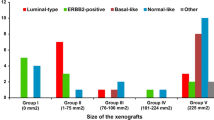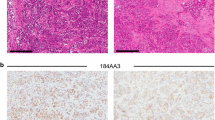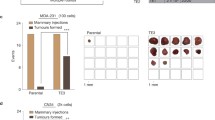Abstract
We have previously isolated a series of MCF-7 human breast cancer cell variants which no longer require estrogen-supplementation for tumor growth in nude mice (Clarkeet al. Proc Natl Acad Sci USA 86: 3649–3653, 1989). We now report that these hormone-independent and hormone-responsive variants (MIII, MCF7/LCC1) can invade locally from solid mammary fat pad tumors, and produce primary extensions on the surface of intraperitoneal structures including liver, pancreas, and diaphragm. Both lymphatic and hematogenous dissemination are observed, resulting in the establishing of pulmonary, bone, and renal metastases. The pattern of metastasis by MIII and MCF7/LCC1 cells closely resembles that frequently observed in breast cancer patients, and provides the first evidence of metastasis from MCF-7 cells growingin vivo without supplementary estrogen. The interexperimental incidence of metastases, and the time from cell inoculation to the appearance of metastatic disease are variable. The increased metastatic potential is not associated with an increase in either the level of laminin attachment, laminin receptor mRNA expression, or secreted type IV collagenolytic activity. We also did not detect a significant decrease in the steady-state mRNA levels of the metastasis inhibitor nm23 gene. However, when growing without estrogenin vitro, MCF7/LCC1 cells produce elevated levels of the estrogen-inducible cathepsin D enzyme.
Similar content being viewed by others
References
Miller AB and Bulbrook RD, 1986, UICC multidisciplinary project on breast cancer: the epidemiology, aetiology and prevention of breast cancer.International Journal of Cancer,37, 173–177.
Fidler IJ and Hart RI, 1982, Biological diversity in metastatic neoplasms: origins and implications.Science,217, 998–1003.
Clarke R, Dickson RB and Brünner N, 1990, The process of malignant progression in human breast cancer.Annals of Oncology,1, 401–407.
Briand P, 1983, Hormone-dependent mammary tumors in mice and rats as a model for human breast cancer.Anticancer Research,3, 273–282.
Kim U and Depowski MJ, 1975, Progression from hormone dependence to autonomy in mammary tumors as an in vivo manifestation of sequential clonal selection.Cancer Research,35, 2068–2077.
Sluyser M and Van Nie R, 1974, Estrogen receptor content and hormone responsive growth of mouse mammary tumors.Cancer Research,34, 3253–3257.
Zhang R, Haag JD and Gould MN, 1990, Reduction in the frequency of activatedras oncogenes in rat mammary carcinomas with increasing N-methyl-N-nitrosourea doses or increasing prolactin levels.Cancer Research,50, 4286–4290.
Sukumar S, Notario V, Martin-Zanca D and Barbacid M, 1983, Induction of mammary carcinomas in rats by nitroso-methylurea involves malignant activation of Ha-ras-1 locus by single point mutations.Nature,306, 658–661.
Zarbl H, Sukumar S, Arthur AV, Martin-Zanca D and Barbacid M, 1985, Direct mutagenesis of H-ras-1 oncogenes by N-nitroso-N-methylurea during initiation of mammary carcinogenesis in rats.Nature,315, 382–385.
Rochlitz CF, Scott GK, Dodson JM, Liu E, Dollbaum C, Smith H and Benz CC, 1989, Incidence of activatingras oncogene mutations associated with primary and metastatic human breast cancer.Cancer Research,49, 357–360.
Albini A, Graf J, Kitten GT, Kleinman HK, Martin GR, Veillette A and Lippman ME, 1986, 17 Betaestradiol regulates and V-Ha-ras transfection con stitutively enhances MCF-7 breast cancer cell interactions with basement membrane.Proceedings of the National Academy of Sciences, U.S.A.,83, 8182–8186.
Kasid A, Lippman ME, Papageorge AG, Lowy DR and Gelmann EP, 1985, Transfection of v-ras H DNA into MCF-7 human breast cancer cells bypas ses dependence on estrogen for tumorigenicity.Science,228, 725–728.
Sommers CL, Papageorge A, Wilding G and Gelmann EP, 1990, Growth properties and tumorigenesis of MCF-7 cells transfected with isogenic mutants ofrasH.Cancer Research,50, 67–71.
Bos JL, 1989,ras Oncogenes in human cancer: a review.Cancer Research,49, 4682–4689.
Seibert K, Shafie SM, Triche TJ, Whang-Peng JJ, O'Brien SJ, Toney JH, Huff KK and Lippman ME, 1983, Clonal variation of MCF-7 breast cancer cellsin vitro and in athymic nude mice.Cancer Research,43, 2223–2239.
Brünner N, Svenstrup B, Spang-Thompson M, Bennet P, Nielsen A and Nielsen JJ, 1986, Serum steroid levels in intact and endocrine ablated Balb/c nude mice and their intact litter mates.Journal of Steroid Biochemistry,25, 429–432.
Ozzello L and Sordat M, 1980, Behavior of tumors produced by transplantation of human mammary cell lines in athymic nude mice.European Journal of Cancer,16, 553–559.
Shafie SM and Liotta LA, 1980, Formation of metastasis by human carcinoma cells (MCF-7) in nude mice.Cancer Letters,11, 81–87.
Levy JA, White AC and McGrath CM, 1982, Growth and histology of a human mammarycarcinoma cell line at different sites in the athymic mouse.British Journal of Cancer,45, 375–383.
Russo J, McGrath C, Russo IH and Rich MA. Tumoral growth of human breast cancer cell line (MCF-7) in athymic mice. In: Nieburg HE, ed.Prevention and Detection of Cancer, pp. 617–626. New York: Marcel Dekker, 1977.
Clarke R, Brünner N, Katz D, Glanz P, Dickson RB, Lippman ME and Kern F, 1989, The effects of a constitutive production of TGF-α on the growth of MCF-7 human breast cancer cellsin vitro andin vivo.Molecular Endocrinology,3, 372–380.
Thompson EW, Paik S, Brünner N, Sommers C, Zugmaier G, Clarke R, Shima TB, Torri J, Donahue S, Lippman ME, Martin GR and Dickson RB, 1992, Association of increased basement membrane-invasiveness with absence of estrogen receptor and expression of vimentin in human breast cancer cell lines.Journal of Cellular Physiology,150, 534–544.
Price JE, Polyzos A, Zhang RD and Daniels LM, 1990, Tumorigenicity and metastasis of human breast carcinoma cell lines in nude mice.Cancer Research,50, 717–721.
Clarke R, Brünner N, Katzenellenbogen BS, Thompson EW, Norman MJ, Koppi C, Paik S, Lippman ME and Dickson RB, 1989, Progression from hormone dependent to hormone independent growth in MCF-7 human breast cancer cells.Proceedings of the National Academy of Sciences, U.S.A.,86, 3649–3653.
Clarke R, Brünner N, Thompson EW, Glanz P, Katz D, Dickson RB and Lippman ME, 1989, The interrelationships between ovarian-independent growth, antiestrogen resistance and invasiveness in the malignant progression of human breast cancer.Journal of Endocrinology,122, 331–340.
Brünner N, Boulay V, Fojo A, Freter C, Lippman ME and Clarke R, 1993, Acquisition of hormone-independence in MCF-7 cells is accompanied by increased expression of estrogen regulated genes but without DNA amplifications.Cancer Research, in press.
Yano T, Korkut E, Pinski J, Szepeshazi K, Milovanovic S, Groot K, Clarke R, Comaru-Schally AM and Schally AV, 1992, Inhibition of growth of MCF-7 MIII human breast carcinoma in nude mice by treatment with agonists or antagonists of LH-RH.Breast Cancer Research and Treatment,21, 35–45.
Fransden TL, Boysen BE, Jirus S, Spang-Thomsen M, Dano K, Thompson EW and Brunner N, 1992, Assays for the study of human cancer cell invasion and metastasis.Fibrinolysis,6), 71–76.
Heussen C and Dowdle EB, 1980, Electrophoretic analysis of plasminogen activators in polyacrylamide gels containing sodium dodecyl sulfate and copoly merized substrates.Analytical Biochemistry,102, 196–202.
Laborda J, 1991, 36B4 cDNA used an an estradiolindependent mRNA control is the cDNA for human acidic ribosomal protein PO.Nucleic Acid Research,19, 3998.
Sasaki M, Kato S, Kohno K, Martin GR and Yamada Y, 1987, Sequence of the cDNA encoding the laminin bl chain reveals a multidomain protein containing cysteine-rich repeats.Proceedings of the National Academy of Sciences, U.S.A.,84, 935–939.
Maniatis T, Fritsch EF and Sambrook J.Molecular Cloning. Cold Spring Harbor, 1982.
Johnson MD, Westley BR and May FEB, 1989, Oestrogenic activity of tamoxifen and its metabolites on gene regulation and cell proliferation in MCF-7 breast cancer cells.British Journal of Cancer,59, 727–738.
Lasky RA and Mills AD, 1975, Quantitative film detection of3H and14C in polyacrylamide gels by fluorography.European Journal of Biochemistry,56, 355.
Schagger H and Von Jagow G, 1987, Tricine-sodium dodecyl sulfate-polyacrylamide gel electrophoresis for the separation of proteins in the range from 1 to 100 kDa.Analytical Biochemistry,166, 368–379.
Thompson EW, Yoon J, Burgess MB, Dickson RB, Goldberg GI, Lippman ME and Kern FG, 1991, Matrix metallo-proteinase family analysis in human breast cancer cell lines of differentialin vivo andin vitro invasiveness.Proceedings of the American Association for Cancer Research,32, 71.
Ballin M, Gomez DE, Sinha CC and Thorgeirsson UP, 1988,Ras oncogene-mediated induction of a 92 kDa metalloproteinase; strong correlation with the malignant phenotype.Biochemical and Biophysical Research Communications,154, 832–838.
Castronovo V, Taraboletti G, Liotta LA and Sobel ME, 1989, Modulation of laminin receptor expression by estrogen and progestins in human breast cancer cell lines.Journal of the National Cancer Institute,81, 781–788.
Steeg PS, Bevilacqua G, Kopper L, Thorgeirsson UP, Talmadge JB, Liotta LA and Sobel ME, 1988, Evidence for a novel gene associated with low tumor metastatic potential.Journal of the National Cancer Institute,80, 200–204.
Bevilacqua G, Sobel ME, Liotta L and Steeg PS, 1989, Association of low nm23 RNA levels in human primary infiltrating ductal breast carcinomas with lymph node involvement and other histopathological indicators of high metastatic potential.Cancer Research,49, 5185–5190.
Scott CD, Martin JL and Baxter RC, 1985, Production of insulin-like growth factor I and its binding protein by adult rat hepatocytes in primary culture.Endocrinology,116, 1094–1101.
Meyvisch C, 1983, Influence of implantation site on formation of metastases.Cancer Metastasis Reviews,2, 295–306.
Volpe JPG and Milas L, 1990, Influence of tumor transplantation methods on tumor growth rate and metastatic potential of solitary tumors derived from metastases.Clinical and Experimental Metastasis,8, 381–389.
Morikawa K, Walker SM, Nakajima M, Pathak S, Jessup JM and Fidler IJ, 1988, Influence of organ environment on the growth, selection, and metastasis of human colon carcinoma cells in nude mice.Cancer Research,48, 6863–6871.
Kozlowski JM, Fidler IJ, Campbell D, Xu Z-L, Kaighn ME and Hart IR, 1984, Metastatic behavior of human tumor cell lines grown in the nude mouse.Cancer Research,44, 3522–3529.
Kerbel RS, Waghorne C, Korczak B, Lagarde A and Breitman ML, 1988, Clonal dominance of primary tumors by metastatic cells: genetic analysis and biological implications.Cancer Surveys,7, 597–629.
Nowell PC, 1976, The clonal evolution of tumor cell populations.Science,194, 23–28.
Nowell PC, 1986, Mechanisms of tumor progression.Cancer Research,46, 2203–2207.
Liotta LA, Rao CN and Barsky SH. Laminin receptors on human breast carcinoma: role in invasion of the extracellular matrix. In: Rich MA, Hager JC and Furmanski P, eds.Understanding Breast Cancer, pp. 87–97. New York: Dekker, 1983.
Albini A, Aukerman SL, Ogle RC, Noonan DM, Fridman R, Martin G and Fidler IJ, 1989, Thein vitro invasiveness and interactions with laminin of K-1735 melanoma cells. Evidence for lamininbinding affinities in high and low metastatic variants.Clinical and Experimental Metastasis,7, 437–451.
Hunt G, 1989, The role of laminin in cancer invasion and metastasis.Experimental Cell Biology,57, 165–176.
Yamada KM, Akiyama SK, Hasegawa T, Hasegawa E and Humphries MJ, 1985, Recent advances in research on fibronectin and other cell attachment proteins.Journal of Cellular Biochemistry,28, 79–97.
Thompson EW, Shima TB, Reich R, Graf J, Albini A, Martin GR, Dickson RB and Lippman ME, 1988, Differential regulation of growth and invasive ness of MCF-7 breast cancer cells by antiestrogens.Cancer Research,48, 6764–6768.
Author information
Authors and Affiliations
Rights and permissions
About this article
Cite this article
Thompson, E.W., Brünner, N., Torri, J. et al. The invasive and metastatic properties of hormone-independent but hormone-responsive variants of MCF-7 human breast cancer cells. Clin Exp Metast 11, 15–26 (1993). https://doi.org/10.1007/BF00880062
Received:
Revised:
Accepted:
Issue Date:
DOI: https://doi.org/10.1007/BF00880062




